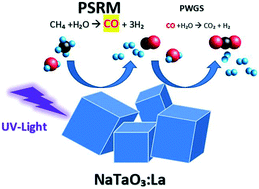Carbon monoxide as an intermediate product in the photocatalytic steam reforming of methane with lanthanum-doped sodium tantalate†
Abstract
Photocatalytic steam reforming of methane (PSRM) has been studied as an attractive method to produce hydrogen by utilizing photoenergy like solar energy at around room temperature with metal-loaded photocatalysts, where methane and water are selectively converted to carbon dioxide and hydrogen. In the present study, we used a PSRM system using a flow reactor at around room temperature to yield the partially oxidized product, carbon monoxide (CO). It was found that some La-doped NaTaO3 samples can produce carbon monoxide constantly in addition to hydrogen and carbon dioxide. Among the prepared samples, a La(2 mol%)-doped NaTaO3 photocatalyst without any cocatalyst exhibited the highest photocatalytic activity and the highest CO selectivity of 24%. The CO yield depended on the photocatalysts and the reaction conditions. Suitable reaction conditions for CO yield were high light intensity, a higher flow rate, and a moderately high methane/water ratio. Some additional reaction tests revealed that water gas shift (WGS) can take place as an undesirable successive reaction, i.e., the produced carbon monoxide can successively react with water to form carbon dioxide, which would restrict the CO yield significantly.



 Please wait while we load your content...
Please wait while we load your content...